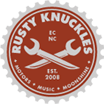Old neon signs just have a cool factor to them like no other. Could it be the idea that we look back at old signage with reverence or the fact that we know that much of the neon we seen is all created by hand? As much as technology and our general apathy grow, laziness abounds as the human condition seems to just be getting easier in the notion that many machines do much of the work for us. We find this to be complete bullshit, as work ethic is everything to us. Fuck lazy people, there we said it direct and to the point. If you are lazy, we have no time for ya, nor want to be around ya. The reason being is that innovation and pure ideas can be anywhere and they are clearly reflected int he sculpture below by Eric Franklin.







Portland-based sculptor Eric Franklin constructs stunning (if not slightly disconcerting) anatomical light structures that are fully hollow and filled with ionized krypton, causing them to glow similar to a neon light. The glass skeleton above, Embodiment, is my jaw-dropping favorite of this series. The piece took over 1,000 hours of work over a two year period and is actually built from 10 separate units of glass formed from borosilicate glass tubing. The process of creating something like this is unbelievably painstaking as Franklin shares via email:
Every glass seal has to be perfect, and this piece contains hundreds. Everywhere one tube joins another, or a tube terminates, glass tubes were sealed together. They have to be perfect in order to preserve the luminosity of the krypton. If one rogue molecule gets inside the void of the glass tubing it can eventually contaminate the gas and it will no longer glow. There are times when the holes in the seals are so small that you cannot actually see them with your eyes without the help of a leak detector. Once the glass pieces are ready to get filled with gas, I pull a high vacuum while the glass is hot in order to evacuate any dust or water vapor from the interior surface until there are literally no molecules inside the void of the glass. Then the krypton can be introduced and the glass sealed off. It’s an extremely tedious process, one I have somewhat of a love/hate relationship with.You can see much more of Franklin’s work on his website, and if you liked this also check out the work of Jessica Lloyd-Jones. Photos above courtesy Brad Carlile. (via my amp goes to 11)



